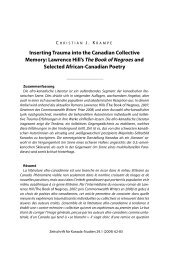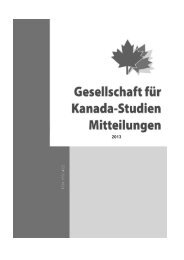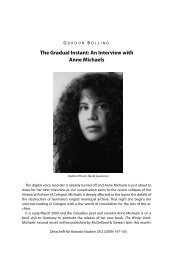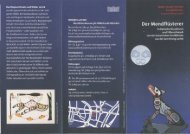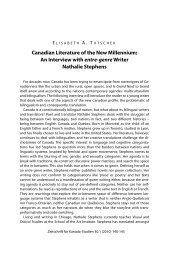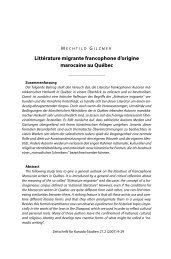The Beginnings of Contemporary Aboriginal Literature in Canada ...
The Beginnings of Contemporary Aboriginal Literature in Canada ...
The Beginnings of Contemporary Aboriginal Literature in Canada ...
Create successful ePaper yourself
Turn your PDF publications into a flip-book with our unique Google optimized e-Paper software.
74 Hartmut Lutz<br />
graph show<strong>in</strong>g thirty residential school students <strong>in</strong> front <strong>of</strong> a build<strong>in</strong>g, Erickson<br />
<strong>in</strong>serted without further commentary the follow<strong>in</strong>g caption like a “found poem”:<br />
I visited the residential school and noticed that the children wore excellent<br />
th<strong>in</strong>gs made from discarded army uniforms. I th<strong>in</strong>k that this is one<br />
<strong>of</strong> the best uses that discarded army uniforms could be put to.<br />
Proceed<strong>in</strong>gs <strong>of</strong> Jo<strong>in</strong>t Committee on the Indian Act 1947.<br />
(Gooderham 1972, 14)<br />
<strong>The</strong> photographs are <strong>in</strong>terspersed with melancholic poetic texts by Sheila Erickson<br />
and extended passages from the Indian Act <strong>of</strong> 1951. Besides, there are two<br />
additional poems <strong>in</strong> the book by <strong>Aborig<strong>in</strong>al</strong> poets Leo Yerxa and Shirley Batt. In the<br />
<strong>in</strong>troduction it says, that the book “is a song <strong>of</strong> praise to the celebration <strong>of</strong> Man and<br />
may represent a different reality for each reader” (2) and the photographs and texts<br />
achieve the aim <strong>of</strong> consciousness-rais<strong>in</strong>g by their coequal visual and verbal appeal,<br />
which strikes the beholder forcefully <strong>in</strong> its jo<strong>in</strong>t impact.<br />
9. Poetry and Early Anthologies<br />
<strong>The</strong> various forms <strong>of</strong> edited Oral Traditions and <strong>of</strong> “consciousness-rais<strong>in</strong>g prose,”<br />
may be classified or even be dismissed as ethnographic or political <strong>in</strong> nature, and<br />
not as literature <strong>in</strong> the narrower sense <strong>of</strong> the term. But poetry is certa<strong>in</strong>ly a literary<br />
genre par excellence. It seems to be the most popular form <strong>of</strong> <strong>Aborig<strong>in</strong>al</strong> selfexpression,<br />
and therefore the most predom<strong>in</strong>ant genre used by Indigenous authors<br />
and by other People <strong>of</strong> Colour <strong>in</strong> North America. In the case <strong>of</strong> <strong>Aborig<strong>in</strong>al</strong> authors,<br />
the preference for poetry may have to do with structural aff<strong>in</strong>ities between poetry<br />
and certa<strong>in</strong> ritualized forms <strong>of</strong> oratory, but more generally the phenomenon is related<br />
to the “bread and butter” issue as addressed by Howard Adams (cf. Adams<br />
1991, 137). For economically and educationally deprived and/or struggl<strong>in</strong>g persons<br />
writ<strong>in</strong>g a short poem seems to be more feasible than the susta<strong>in</strong>ed and costly effort<br />
<strong>of</strong> writ<strong>in</strong>g a full-length novel or drama. Individual poems or forms <strong>of</strong> lyrical prose<br />
appeared scattered throughout the 1960s – e.g. Clutesi’s poem “West Coast Indian,”<br />
Tony Mandam<strong>in</strong>’s “On Education” <strong>in</strong> Who Is the Chairman <strong>of</strong> this Meet<strong>in</strong>g?, Sheila<br />
Erickson’s poems <strong>in</strong> Notice: This Is An Indian Reserve, or the various poems <strong>in</strong> Akwesasne<br />
Notes – but there were no special poetry anthologies or poetry books by <strong>in</strong>dividual<br />
<strong>Aborig<strong>in</strong>al</strong> authors until the early 1970s <strong>in</strong> <strong>Canada</strong>, and they made their appearance<br />
via the United States.<br />
In 1971 Richard Lewis edited an anthology <strong>of</strong> Inuit poetry, I Breathe a New Song,<br />
illustrated by Oonark and <strong>in</strong>troduced by Edmund Carpenter. <strong>The</strong> book came out <strong>in</strong><br />
New York, but the poems come from all over the North American Arctic. It is a selection<br />
<strong>of</strong> beautiful texts <strong>in</strong> English translation. Older anonymous poems and contem-



